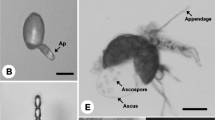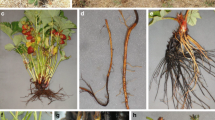Abstract
In this study, strawberry plants (Fragaria × ananassa Duchesne ex Rozier) grown via elevated cultivation in a greenhouse were heavily infested with powdery mildew. We isolated the powdery mildew fungus from strawberry leaves and identified the isolate as Podosphaera aphanis (Wallroth) U. Braun & S. Takamatsu var. aphanis KSP-7 N, based on its morphological characteristics and sequencing of the ribosomal DNA internal transcribed spacer region. The host range of KSP-7 N was assessed by inoculating 17 plant families comprising 49 species (a total of 110 cultivars) with conidia. The fungus caused severe powdery mildew on the tested strawberry plants (commercial, wild, and false strawberries), produced scattered conidia on conidiophores, and formed completely catenated conidia within approximately 27 h from conidiophore erection to the first release of mature conidia. Six conidia were produced on each conidiophore; only those at the apex reached maturity. The cycles of conidial release were repeated 17 to 21 times at intervals of approximately 6 h, during gradual upward elongation of the conidiophores. At the final stage, conidia were released without growth or septation of the generative cells. Conidiophores produced an average of 38 conidia during a 96-h period. These results will help to clarify the modes of conidiogenesis, the lifetime of conidiophores, and the production of conidia on a conidiophore among powdery mildew pathogens isolated from strawberry leaves.







Similar content being viewed by others
References
Abiko K (1982) Specialization of parasitism of Sphaerotheca humuli (DC.) Burr Bull Veg Ornam Crops Res Stn Japan. Ser A 10:69–74 (In Japanese with English summary)
Bal E, Gilles G (1986) Problems of resistance in powdery mildew control on strawberries. Mededelingen van de Faculteit Landbouwwetenschappen. Rijksuniversiteit Gent 51(2b):707–714
Boesewinkel HJ (1980) The morphology of the imperfect stages of powdery mildews (Erysiphaceae). Bot Rev 46:167–224
Braun U (1987) A monograph of the Erysiphales (powdery mildews). Beih Nova Hedwig 89:1–700
Braun U, Cook RTA (2012) In: Taxonomic Manual of the Erysiphales (Powdery Mildews). CBS-KNAW Fungal Biodiversity Centre, The Netherlands
Braun U, Takamatsu S (2000) Phylogeny of Erysiphe, Microsphaera, Uncinula (Erysipheae) and Cystotheca, Podosphaera, Sphaerotheca (Cystotheceae) inferred from rDNA ITS sequences – some taxonomic consequences. Schlechtendalia 4:1–33
Calis O, Cekic C, Soylu S, Tor M (2015) Identification of new resistantance sources from diploid wild strawberry against powdery mildew pathogen. Pak J Agri Sci 52:677–683
Carisse O, Morissette-Thomas V, van der Heyden H (2013) Lagged association between powdery mildew leaf severity, airborne inoculum, weather, and crop losses in strawberry. Phytopathology 103:811–821
Cockerton HM, Vickerstaff RJ, Karlström A, Wilson F, Sobczyk M, He JQ, Sargent DJ, Passey AJ, McLeary KJ, Pakozdi K, Harrison N, Lumbreras-Martinez M, Antanaviciute L, Simpson DW, Harrison RJ (2018) Identification of powdery mildew resistance QTL in strawberry (Fragaria x ananassa). Theor Appl Genet 131:1995–2007
Davik J, Honne BI (2005) Genetic variance and breeding values for resistance to a wind-borne disease [Sphaerotheca macularis (Wallr. ex Fr.)] in strawberry (Fragaria x ananassa Duch.) estimated by exploring mixed and spatial models and pedigree information. Theor Appl Genet 111:256–264
De Cal A, Redondo C, Sztejnberg A, Melgarejo P (2008) Biocontrol of powdery mildew by Penicillium oxalicum in open-field nurseries of strawberries. Biol Control 47:103–107
de los Santos B, Blanco C, Porras M, Barrau C, Romero F (2002) First confirmation of Sphaerotheca macularis on strawberry plants in southwesthern Spain. Plant Dis 86:1049
Farooq M, Dodgson J, Hall AM (2007) Examination of the morphology of Podosphaera aphanis cleistothecia and their role in over wintering of the fungus. Asp Appl Biol 83:55–58
Freeman JA, Pepin HS (1967) A systemic fungicide (fungicide 1991) for the control of gray mold and powdery mildew in strawberries and rasberries. Can Plant Dis Surv 47:104–107
Harvey N, Xu X-M (2010) Powdery mildew on raspberry is genetically different from strawberry powdery mildew. JPP 92:775–779
Hollomon DW, Wheeler IE (2002) Controlling powdery mildews with chemistry. In: Belanger RR, Bushnell WR, Dik AJ, Carver TLW (eds) The powdery mildews: a comprehensive treatise. APS Press, St. Paul, Minnesota, pp 249–255
Homma Y (1937) Erysiphaceae of Japan. J Fac Agric, Hokkaido Imperial Univ 38:183–461
Hori S (1932) New diseases of strawberry and tomato in glass-house and heat-planting. Jissai Engei (Practical Horticulture) 12:502–505 (in Japanese)
Howard CM, Albregts EE (1982) Cleistothecia of Sphaerotheca macularis on strawberry plants in Florida. Plant Dis 66:261–262
Hukkanen AT, Kokko HI, Buchala AJ, McDougall GJ, Stewart D, Kärenlampi SO, Karjalainen RO (2007) Benzothiadiazole induces the accumulation of phenolics and improves resistance to powdery mildew in strawberries. J Agric Food Chem 55:1862–1870
Janisiewicz WJ, Takeda F, Jurick W, Nichols B, Wolford S, Glenn DM (2015) A novel approach to control gray mold, anthracnose, and powdery mildew on strawberry using low-dose UV-C irradiation. Phytopathology 105(S4):64
Jhooty JS, McKeen WE (1962) The perfect stage of Sphaerotheca macularis on strawberry plants. Plant Dis Reptr 46:218–219
Jhooty JS, McKeen WE (1965) Studies on powdery mildew of strawberry caused by Sphaerotheca macularis. Phytopathology 55:281–285
Kanto T, Matsuura K, Ogawa T, Yamada M, Ishiwata M, Usami T, Amemiya Y (2014) A new UV-B lighting system controls powdery mildew of strawberry. Acta Hortic 1049:655–660
Karajeh MR, Al-Rawashdeh ZB, Al-Dein E, Al-Ramamneh M (2012) Occurrence and control of strawberry powdery mildew in Al-Shoubak/Jordan. JJAS 8:380–390
Kashimoto K, Matsuda Y, Matsutani K, Sameshima T, Kakutani K, Nonomura T, Okada K, Kusakari S, Nakata K, Takamatsu S, Toyoda H (2003) Morphological and molecular characterization for a Japanese isolate of tomato powdery mildew Oidium neolycopersici and its host range. J Gen Plant Pathol 69:176–185
Legard DE, Chandler CK (2000) Evaluation of fungicides to control powdery mildew of strawberry, 1998. Fungic Nematic Tests 55:128
Maas JL (1998) In: Compendium of strawberry diseases, 2nd edn. APS Press, St. Paul, Minnesota
Matsuda Y, Ikeda H, Moriura N, Tanaka N, Shimizu K, Oichi W, Nonomura T, Kakutani K, Kusakari S, Higashi K, Toyoda H (2006) A new spore precipitator with polarized dielectric insulators for physical control of tomato powdery mildew. Phytopathology 96:967–974
Matsuda Y, Sameshima T, Moriura N, Inoue K, Nonomura T, Kakutani K, Nishimura H, Kusakari S, Takamatsu S, Toyoda H (2005) Identification of individual powdery mildew fungi infecting leaves and direct detection of gene expression by single conidium polymerase chain reaction. Phytopathology 95:1137–1143
Miller TC, Gubler WD, Laemmlen FF, Geng S, Rizzo DM (2004) Potential for using Lecanicillium lecanii for suppression of strawberry powdery mildew. Biocont Sci Technol 14:215–220
Moriura N, Matsuda Y, Oichi W, Nakashima S, Hirai T, Sameshima T, Nonomura T, Kakutani K, Kusakari S, Higashi K, Toyoda H (2006) Consecutive monitoring of lifelong production of conidia by individual conidiophores of Blumeria graminis f. sp. hordei on barley leaves by digital microscopic techniques with electrostatic micromanipulation. Mycol Res 110:18–27
Nakazawa Y, Uchida K (1998) First record of cleistothecial stage of powdery mildew fungus on strawberry in Japan. Ann Phytopathol Soc Japan 64:121–124
Nelson MD, Gubler WD, Shaw DV (1995) Inheritance of powdery mildew resistance in greenhouse-grown versus field-grown California strawberry progenies. Phytopathology 85:421–424
Nelson MD, Gubler WD, Shaw DV (1996) Relative resistance of 47 strawberry cultivars to powdery mildew in California greenhouse and field environments. Plant Dis 80:326–328
Nonomura T, Matsuda Y, Yamashita S, Akahoshi H, Takikawa Y, Kakutani K, Toyoda H (2013) Natural woody plant, Mallotus japonicus, as an ecological partner to transfer different pathotypic conidia of Oidium neolycopersici to greenhouse tomatoes. Plant Protect Sci 49:S33–S40
Nonomura T, Matsuda Y, Xu L, Kakutani K, Takikawa Y, Toyoda H (2009) Collection of highly germinative pseudochain conidia of Oidium neolycopersici from conidiophores by electrostatic attraction. Mycol Res 113:364–372
Okayama K, Nakano T, Matsutani S, Sugimura T (1995) A simple and reliable method for evaluating the effectiveness of fungicides for control of powdery mildew (Sphaerotheca macularis) on strawberry. Ann Phytopathol Soc Japan 61:536–540
Oichi W, Matsuda Y, Sameshima T, Nonomura T, Kakutani K, Nishimura H, Kusakari S, Toyoda H (2004) Consecutive monitoring for conidiogenesis by Oidium neolycopersici on tomato leaves with a high-fidelity digital microscope. J Gen Plant Pathol 70:329–332
Oichi W, Matsuda Y, Nonomura T, Toyoda H, Xu L, Kusakari S (2006) Formation of conidial pseudochains by tomato powdery mildew Oidium neolycopersici. Plant Dis 90:915–919
Paulus AO (1990) Fungal diseases of strawberry. HortSci 25:885–889
Peries OS (1962a) Studies on strawberry mildew, caused by Sphaerotheca macularis (Wallr. ex Fries) Jaczewski. I. Biology of the fungus. Ann Appl Biol 50:211–224
Peries OS (1962b) Studies on strawberry mildew, caused by Sphaerotheca macularis (Wallr. ex Fries) Jaczewski. II. Host-parasite relationships on the foliage of strawberry varieties. Ann Appl Biol 50:225–233
Pertot I, Zasso R, Amsalem L, Baldessari M, Angeli G, Elad Y (2008) Integrating biocontrol agents in strawberry powdery mildew control strategies in high tunnel growing systems. Crop Prot 27:622–631
Salmon ES (1900) The strawberry mildew (Sphaerotheca humuli (DC.) Burr.). J Royal Hortic Soc 25:132–138
Sameshima T, Kashimoto K, Kida K, Matsuda Y, Nonomura T, Kakutani K, Nakata K, Kusakari S, Toyoda H (2004) Cytological events in tomato leaves inoculated with conidia of Blumeria graminis f. sp. hordei and Oidium neolycopersici KTP-01. J Gen Plant Pathol 70:7–10
Seifi A, Nonomura T, Matsuda Y, Toyoda H, Bai Y (2012) An avirulent tomato powdery mildew isolate induces localized acquired resistance to a virulent isolate in a spatiotemporal manner. Mol Plant-Microbe Interact 25:372–378
Sombardier A, Dufour M-C, Blancard D, Corio-Costet M-F (2010) Sensitivity of Podosphaera aphanis isolates to DMI fungicides: distribution and reduced cross-sensitivity. Pest Manag Sci 66:35–43
Spencer DM (1978) Powdery mildew of strawberries. In: Spencer DM (ed) The Powdery Mildews. Academic Press, New York, pp 355–358
Takamatsu S, Niinomi S, Harada M, Havrylenko M (2010) Molecular phylogenetic analyses reveal a close evolutionary relationship between Podosphaera (Erysiphales: Erysiphaceae) and its rosaceous hosts. Persoonia 24:38–48
Takikawa Y, Kakutani K, Nonomura T, Matsuda Y, Toyoda H (2011) Conidia of Erysiphe trifoliorum attempt penetration twice during a two-step germination process on non-host barley leaves and an artificial hydrophobic surface. Mycoscience 52:204–209
Takikawa Y, Nonomura T, Miyamoto S, Okamoto N, Murakami T, Matsuda Y, Kakutani K, Kusakari S, Toyoda H (2015) Digital microscopic analysis of conidiogenesis of powdery mildew pathogens isolated from melon leaves. Phytoparasitica 43:517–530
Tanigawa M, Nakano T, Hagihara T, Okayama K, Sezaki S (1993) Relationship between the control effect of fungicides on powdery mildew (Sphaerotheca humuli) and their deposits on strawberry leaves. J Pesticide Sci 18:135–140
White TJ, Bruns T, Lee S, Taylor J (1990) Amplification and direct sequencing of fungal ribosomal RNA genes for phylogenetics. In: Innis MA, Gelfand DH, Sninsly JJ, White TJ (eds) PCR protocols: a guide to methods and applications. Academic Press, New York, pp 315–322
Willocquet L, Sombardier A, Blancard D, Jolivet J, Savary S (2008) Spore dispersal and disease gradients in strawberry powdery mildew. Can J Plant Pathol 30:434–441
Xiao CL, Chandler CK, Price JF, Duval JR, Mertely JC, Legard DE (2001) Comparison of epidemics of Botrytis fruit rot and powdery mildew of strawberry in large plastic tunnel and field prouduction systems. Plant Dis 85:901–909
Acknowledgements
This work was partly supported by Grants for Scientific Research from Faculty of Agriculture, Kindai University, and Agricultural Technology and Innovation Research Institute, Kindai University. The authors acknowledge the assistance of two professional editors who assisted with the English and grammar.
Author information
Authors and Affiliations
Corresponding author
Ethics declarations
Open Access
This article is distributed under the terms of the Creative Commons Attribution 4.0 International License (http://creativecommons.org/licenses/by/4.0/), which permits unrestricted use, distribution, and reproduction in any medium, provided you give appropriate credit to the original author(s) and the source, provide a link to the Creative Commons license, and indicate if changes were made.
Conflict of interest
The authors declare that they have no conflict of interest.
Rights and permissions
About this article
Cite this article
Iwasaki, S., Asano, S., Yoshida, K. et al. Analysis of conidiogenesis and lifelong conidial production from single conidiophores of Podosphaera aphanis on strawberry leaves using digital microscopic and electrostatic techniques. Australasian Plant Pathol. 50, 571–587 (2021). https://doi.org/10.1007/s13313-021-00794-0
Received:
Accepted:
Published:
Issue Date:
DOI: https://doi.org/10.1007/s13313-021-00794-0




